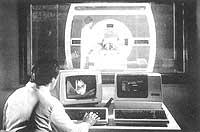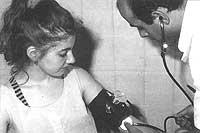Checks: Are they really necessary?

Without too much fear of making a mistake, we could say that women see the annual checkup or sanitary inspection with quite good eyes, because they are convinced that many problems emerge. However, we could not say the same of men, although in those previous statements the exceptions are two-sided.
For years it has been considered, without a doubt, that the annual inspection is recommended for health surveillance, as well as dental cleaning or anti-measles vaccination. But for most of us, in cinema it was only something Americans did. When one of us went to the doctor asking for a checkup, the doctor did not see him with good eyes. If he did not cast him out of his consultation, he condemns.
In the United States, after the Second World War, they thought that science was capable of solving anything. And in this environment the idea of the annual review was put. At the arrival of the 1960s, the fact that blood tests could be performed by computer meant that 20 were done, which previously cost a single analysis. Most were useless, but as they could be done, they were made.
On the other hand, it is no coincidence that in this same period the periodic inspections of the cars are also reinforced. If a car survives by inspecting or checking periodically, wouldn't the same happen with humans?
Since then, things don't look so clear, and you've heard of the disadvantages and disadvantages of these periodic checks and their importance on all benefits and benefits. Today, despite the shortage of physicians who completely discard physical exams, many consider that compulsory testing is only a few and not annually. At one point the most important lack of agreement is concentrated today: how often a person should go to the doctor by routine (h.d. without any clear illness, so that you can check them out?
Opinions are of all tastes, but some models have begun to impose themselves and the most recommended plan would be age 18-35 every 4 years, 36-45 every 3 years, 46-55 every 2 years, more than 55 years each year or by medical prescription.
In addition to reducing the frequency of medical recognitions, there are more and more doctors who select the tests to be done. Previously, the need to use advanced tools and sciences to carry out an adequate preventive medicine was correctly seen. And that is not true, or it is not an obligatory truth. The best studies are the simplest. Electrocardiograms, complex stress tests, scanners and other sophisticated equipment are not necessary in routine checks.

According to the last criteria, four are the diseases that can be detected in the basic study. However, this plan is proposed for healthy people who have no special risk factor. If there are factors that exceed the mean (for example, very high voltage), the doctor may want to perform some specific test more often.
- In women, cervical cancer can be detected by a cytology. This simple test has saved the lives of hundreds of thousands of women in recent years. Following a rule given in 1976, after two consecutive years of cytologies with normal results, a woman should repeat the test every 3 years until age 35; then every 5 years and after 60 years, if all previous tests are normal. Hypertension is one of the diseases that should be controlled periodically for the effects that may result from not being intervened and treated on time. If a person has normal stress it will be enough to control it every 2 years and every year from 50. Intestinal cancer stands out by means of hemorrhages. Checking the presence of blood in the stool can give us the feeling of colon cancer. These exams should begin at age 40 and be repeated annually from age 50.
- Breast cancer is a cancer that can be detected on many occasions in the physical exam and should be done to all women annually. But this is not the best way for prevention. Since between 80% and 90% of the edibles that appear in the breasts are first touched by the women themselves, once a month the woman should review her breasts (especially when she has just had the rule). According to experts, with this simple motorway, 7 out of 100 cases of breast cancer are diagnosed and saved. The annual study increases the odds if a mammography is performed in this study (i.e., a study of the X-ray breasts). For this reason, the American Cancer Association recommends that women between 50 and 49 years of age perform an annual or biannual mammography and their annual recurrence from 50 years of age. It should not be forgotten that breast cancer is the most common risk of death in women aged 35 to 74.
Annual physical review in preventive medicine, h.d. Retire forever and the next area of analysis is not the most appropriate procedure. But there are many doctors who want to see their patients, although only once a year, and take advantage of these possibilities to maintain and accelerate the medical-sick relationship. Doctors are also known to be more interested in the patient they know, although theoretically it is the same for everyone.





